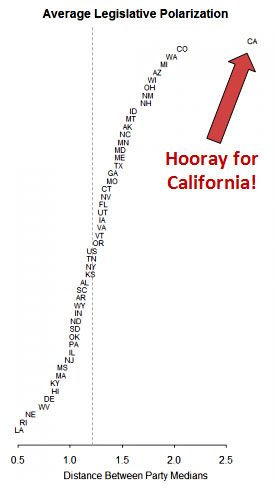 “Those of us who report on state-level politics,” writes Abby Rapoport today, “usually brag about how much better it is than following Congress.” Really? I’ve always thought of state capitols as cesspools that make Congress look like a finely crafted Swiss watch. What’s going on here?
“Those of us who report on state-level politics,” writes Abby Rapoport today, “usually brag about how much better it is than following Congress.” Really? I’ve always thought of state capitols as cesspools that make Congress look like a finely crafted Swiss watch. What’s going on here?
The answer, it turns out, is location, location, location. The chart on the right shows the average polarization of all 50 state legislatures, which is a pretty good proxy for gridlock and general cesspoolishness. My state isn’t merely the most polarized, it’s literally in a class by itself. No wonder I think of state politics as insufferable. In California, it is.
So it’s true: California really is two states. Not northern and southern, though. Unless water is involved, LA and San Francisco can get along OK. Basically, what this chart shows is coastal vs. inland. Most of coastal California is as liberal as its stereotype, while inland California is somewhere to the right of rural Georgia. Lately, the coastals have taken firm command of Sacramento, and the inlanders haven’t yet figured out how to respond. I don’t think they will anytime soon.













